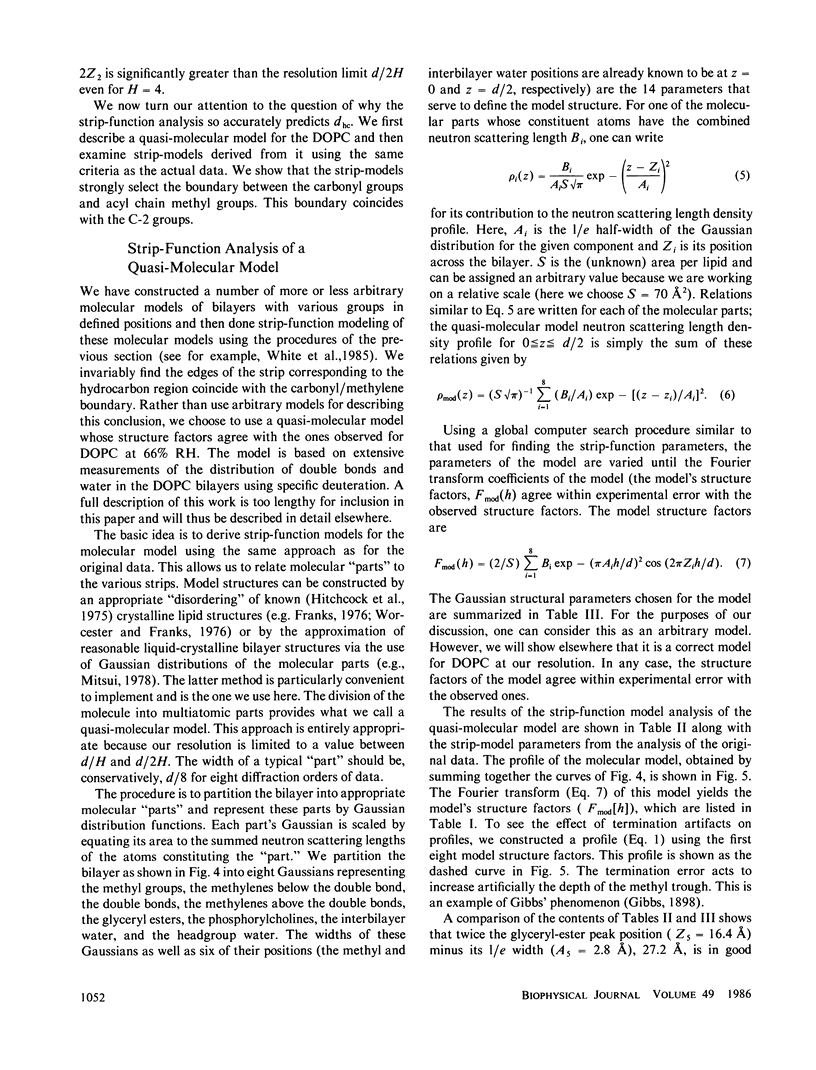Abstract
Neutron diffraction methods provide information about the distribution of matter in biological and model membrane systems. The information is derived from plots (profiles) of scattering length density along an axis normal to the membrane plane. Without the use of specific deuteration, the generally low resolution of the profiles limits their interpretation in terms of specific chemical constituents (e.g., lipid headgroup, lipid hydrocarbon, protein, and water). A fundamental and useful structural assignment to make is the boundary between the headgroup and hydrocarbon regions of bilayers. We demonstrate here that strip-function model representations of neutron scattering length density profiles of bilayers are sufficient to determine accurately the position of the headgroup-hydrocarbon boundary. The resulting hydrocarbon thickness of the bilayer is useful for determining the area per lipid molecule and consequently the molecular packing arrangements of the membrane constituents. We analyze data obtained from dioleoylphosphatidylcholine (DOPC) bilayers at 66% RH using standard Fourier profile analyses and from DOPC deuterated specifically at the C-2 carbon of the acyl chains using difference Fourier analysis. We demonstrate that strip-function models accurately define the positions of the C-2 carbons and thus the hydrocarbon thickness (dhc) of the bilayer. We then show, using quasi-molecular models, that the strip-model analysis probably provides an accurate measure of dhc because of the exceptionally high scattering length density difference between the carbonyl and methylene groups.
Full text
PDF







Selected References
These references are in PubMed. This may not be the complete list of references from this article.
- Blaurock A. E., Worthington C. R. Treatment of low angle x-ray data from planar and concentric multilayered structures. Biophys J. 1966 May;6(3):305–312. doi: 10.1016/S0006-3495(66)86658-4. [DOI] [PMC free article] [PubMed] [Google Scholar]
- Büldt G., Gally H. U., Seelig A., Seelig J., Zaccai G. Neutron diffraction studies on selectively deuterated phospholipid bilayers. Nature. 1978 Jan 12;271(5641):182–184. doi: 10.1038/271182a0. [DOI] [PubMed] [Google Scholar]
- Büldt G., Gally H. U., Seelig J., Zaccai G. Neutron diffraction studies on phosphatidylcholine model membranes. I. Head group conformation. J Mol Biol. 1979 Nov 15;134(4):673–691. doi: 10.1016/0022-2836(79)90479-0. [DOI] [PubMed] [Google Scholar]
- Franks N. P., Arunachalam T., Caspi E. A direct method for determination of membrane electron density profiles on an absolute scale. Nature. 1978 Nov 30;276(5687):530–532. doi: 10.1038/276530a0. [DOI] [PubMed] [Google Scholar]
- Franks N. P. Structural analysis of hydrated egg lecithin and cholesterol bilayers. I. X-ray diffraction. J Mol Biol. 1976 Jan 25;100(3):345–358. doi: 10.1016/s0022-2836(76)80067-8. [DOI] [PubMed] [Google Scholar]
- Hitchcock P. B., Mason R., Shipley G. G. Phospholipid arrangements in multilayers and artificial membranes: quantitative analysis of the X-ray diffraction data from a multilayer of 1,2-dimyristoyl-DL-phosphatidylethanolamine. J Mol Biol. 1975 May 15;94(2):297–299. doi: 10.1016/0022-2836(75)90084-4. [DOI] [PubMed] [Google Scholar]
- Jendrasiak G. L., Hasty J. H. The hydration of phospholipids. Biochim Biophys Acta. 1974 Jan 23;337(1):79–91. doi: 10.1016/0005-2760(74)90042-3. [DOI] [PubMed] [Google Scholar]
- King G. I., Jacobs R. E., White S. H. Hexane dissolved in dioleoyllecithin bilayers has a partial molar volume of approximately zero. Biochemistry. 1985 Aug 13;24(17):4637–4645. doi: 10.1021/bi00338a024. [DOI] [PubMed] [Google Scholar]
- Levine Y. K., Wilkins M. H. Structure of oriented lipid bilayers. Nat New Biol. 1971 Mar 17;230(11):69–72. doi: 10.1038/newbio230069a0. [DOI] [PubMed] [Google Scholar]
- Lewis B. A., Engelman D. M. Lipid bilayer thickness varies linearly with acyl chain length in fluid phosphatidylcholine vesicles. J Mol Biol. 1983 May 15;166(2):211–217. doi: 10.1016/s0022-2836(83)80007-2. [DOI] [PubMed] [Google Scholar]
- Mitsui T. X-ray diffraction studies of membranes. Adv Biophys. 1978;10:97–135. [PubMed] [Google Scholar]
- Simon S. A., McIntosh T. J., Latorre R. Influence of cholesterol on water penetration into bilayers. Science. 1982 Apr 2;216(4541):65–67. doi: 10.1126/science.7063872. [DOI] [PubMed] [Google Scholar]
- Small D. M. Phase equilibria and structure of dry and hydrated egg lecithin. J Lipid Res. 1967 Nov;8(6):551–557. [PubMed] [Google Scholar]
- White S. H. Formation of "solvent-free" black lipid bilayer membranes from glyceryl monooleate dispersed in squalene. Biophys J. 1978 Sep;23(3):337–347. doi: 10.1016/S0006-3495(78)85453-8. [DOI] [PMC free article] [PubMed] [Google Scholar]
- White S. H., King G. I. Molecular packing and area compressibility of lipid bilayers. Proc Natl Acad Sci U S A. 1985 Oct;82(19):6532–6536. doi: 10.1073/pnas.82.19.6532. [DOI] [PMC free article] [PubMed] [Google Scholar]
- Worcester D. L., Franks N. P. Structural analysis of hydrated egg lecithin and cholesterol bilayers. II. Neutrol diffraction. J Mol Biol. 1976 Jan 25;100(3):359–378. doi: 10.1016/s0022-2836(76)80068-x. [DOI] [PubMed] [Google Scholar]
- Worthington C. R. The interpretation of low-angle X-ray data from planar and concentric multilayered structures. The use of one-dimensional electron density strip models. Biophys J. 1969 Feb;9(2):222–234. doi: 10.1016/S0006-3495(69)86381-2. [DOI] [PMC free article] [PubMed] [Google Scholar]
- Zaccai G., Blasie J. K., Schoenborn B. P. Neutron diffraction studies on the location of water in lecithin bilayer model membranes. Proc Natl Acad Sci U S A. 1975 Jan;72(1):376–380. doi: 10.1073/pnas.72.1.376. [DOI] [PMC free article] [PubMed] [Google Scholar]
- Zaccai G., Büldt G., Seelig A., Seelig J. Neutron diffraction studies on phosphatidylcholine model membranes. II. Chain conformation and segmental disorder. J Mol Biol. 1979 Nov 15;134(4):693–706. doi: 10.1016/0022-2836(79)90480-7. [DOI] [PubMed] [Google Scholar]


